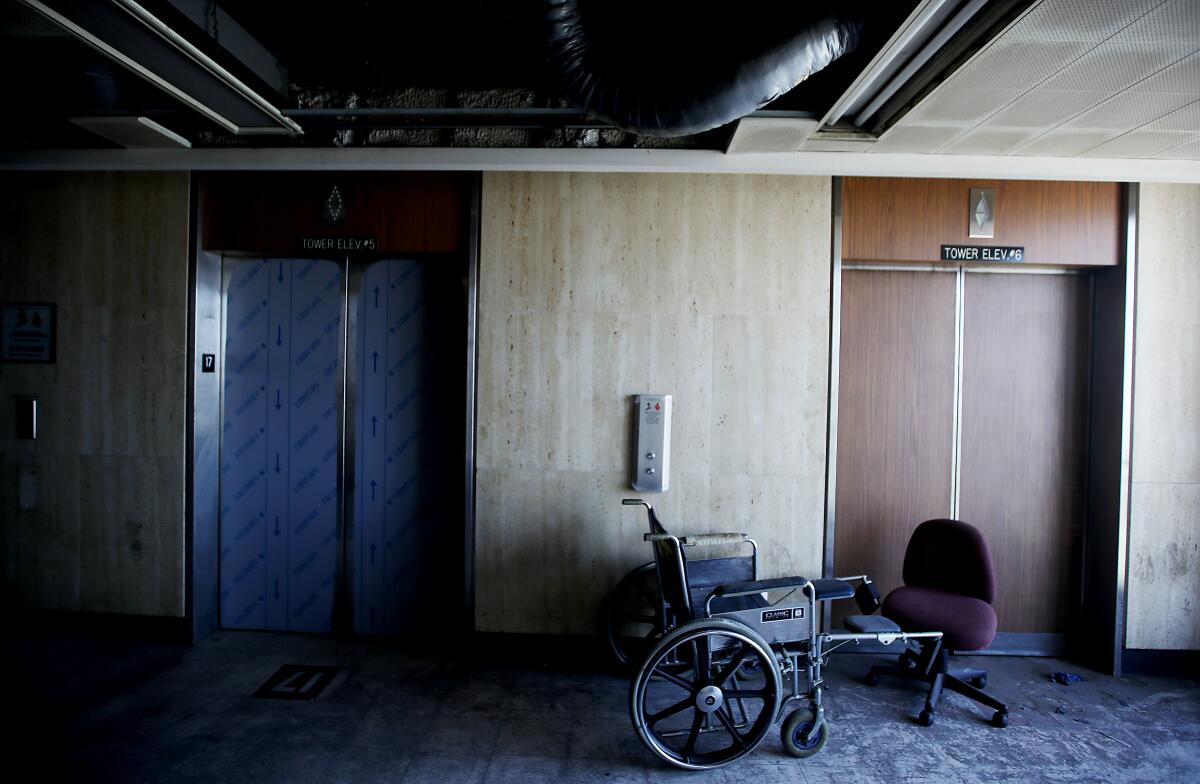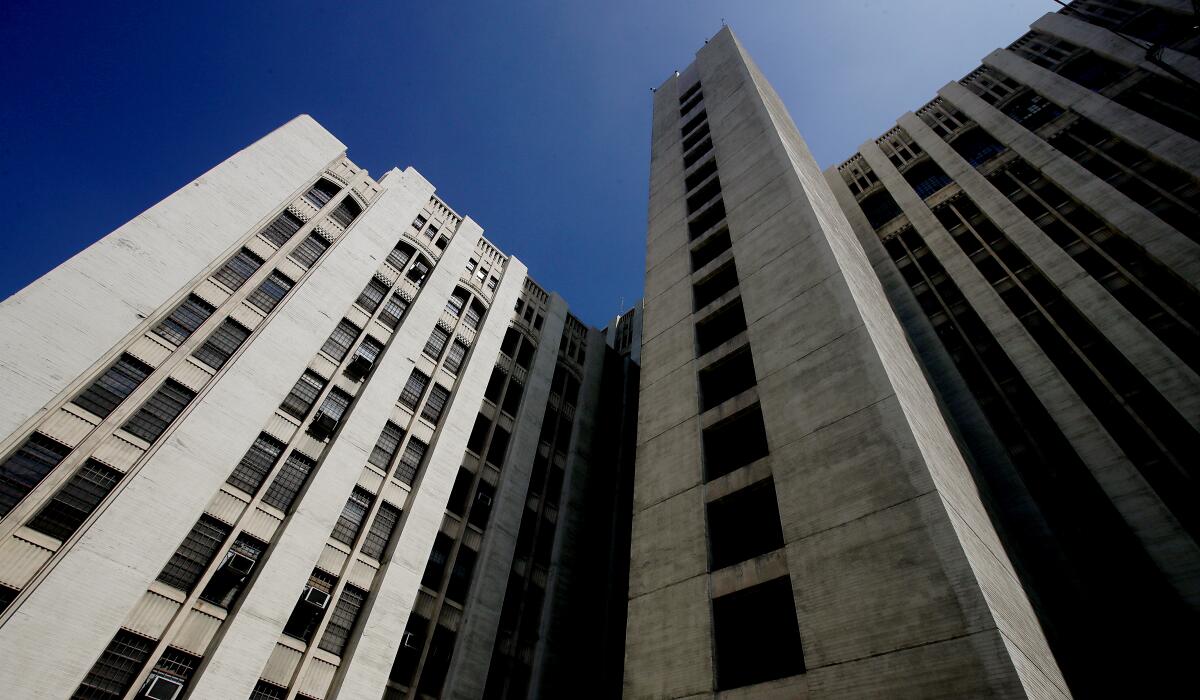L.A. County Supervisors select a developer for $1-billion revamp of General Hospital

- Share via
A Culver City-based developer that specializes in bringing capital to low-income communities has been selected to renovate the landmark General Hospital building in Boyle Heights and develop its 25-acre grounds as a community and wellness center.
The Los Angeles County Board of Supervisors voted Tuesday to enter into an exclusive negotiating agreement with Centennial Partners, a joint venture led by Primestor Venture Partners, the Latino-owned company that built the retail center in the city’s redevelopment of the Jordan Downs housing project in South Los Angeles and led the restoration of the Paul Williams-designed Golden State Mutual Life Insurance Building in the Adams-Normandie neighborhood.
Primestor and its joint-venture partner Bayspring Real Estate Partners will have 18 months, with potential extensions, to negotiate final plans to retrofit the 19-story former hospital, convert it to housing and develop additional housing, retail, offices, sports facilities and parks on land to the west that is currently occupied by small buildings and a parking lot.
The county has committed $129 million in local, state and federal funds for the public-private partnership, which is expected to cost close to $1 billion.
“Revitalizing the historic General Hospital building and developing the surrounding land represents an opportunity to create a significant number of housing units,” said Supervisor Hilda Solis, who spearheaded the project. “In that space we can construct up to 1,000 units of desperately needed housing. The community has called for low-income and affordable housing units. That is what we hope to deliver.”

Several dozen public speakers representing community groups, health and homeless organizations and labor, as well as Los Angeles Mayor Karen Bass and City Councilwoman Eunisses Hernandez, spoke in favor of the project, some citing specific wishes such as a quality restaurant and more housing for extremely low-income people.
The board approved Solis’ motion 4 to 0; Supervisor Janice Hahn, who had recently received a contribution from a party to the agreement, recused herself.
In its 267-page proposal, Primestor characterized the project as “an integrated, sustainable and walkable neighborhood that incorporates commercial spaces catering to a wide range of employment opportunities” at the nexus of Boyle Heights, Lincoln Heights, East Los Angeles and El Sereno.
After standing mostly vacant for the last 14 years, the iconic General Hospital is nearing a reincarnation as affordable and homeless housing.
The proposal shows three generalized options: one weighted toward more community uses, one toward office space and one toward residential.
Primestor founding partner and Chief Executive Arturo Sneider said the proposal left options open to allow the development to respond to community preferences.
“We feel strongly about the fact that for over three decades, we have been delivering over and over again a very different approach to development, where the people who live there have a voice, versus coming in and saying, ‘We know exactly what the community wants and needs,’ without taking the time to listen to them,” Sneider said.
Opened in 1934, the hospital became the centerpiece of L.A.’s healthcare system, a role that gradually diminished as the region expanded after World War II.
As early as the 1960s, the facility was straining to keep pace with advances in medical technology. Lacking air conditioning and fire sprinklers, it fell out of compliance with tightening air-quality and fire standards.
The supervisors voted in 1990 to begin construction of a replacement. The 1994 Northridge earthquake forced the permanent closure of a 166-bed psychiatric unit and led to new state seismic standards for hospitals that would require structural upgrades of the massive main building. After the County-USC Medical Center, now called Los Angeles General Medical Center, opened nearby, General Hospital closed on Nov. 7, 2008.

Only its lower four stories remain in use; today, they house a community wellness center, research teams and training programs.
For years, county officials tossed around ideas for repurposing the building. Nothing came of the talk until 2018, when the supervisors approved Solis’ motion for a feasibility study on converting the hospital to housing. Broadly defining community-oriented goals, she said the reborn building should complement the existing health services and focus on the most vulnerable population by providing recuperative care, housing, jobs and wraparound services.
The county hired AECOM, a national infrastructure analysis firm, to produce market studies and analyze the building’s structural integrity.
Solis created an oversight group, the Health Innovation Community Partnership, which gathered leaders of nonprofits, businesses and resident associations from downtown to El Sereno to review the evolving plans.
Meanwhile, the county began development of what it called the Restorative Care Village on the northern portion of the property, with 64 beds for residential mental healthcare and contracting with a developer for 300 units of affordable housing and housing for the homeless. It also demolished the former Women’s and Children’s Hospital, where additional mental health and medical recovery facilities, as well as a job development center, are slated.
In its proposal, Primestor said it aspired to “bring about the return of the Los Angeles County General Hospital as a symbol of well-being at the center of an active community.”
While offering options, the proposal lists specific targets: 885 housing units, of which 30% would be affordable; 145,000 square feet of commercial medical, lab and office space; 168,000 square feet of retail space, plus a grocery store, library, sports courts, daycare center and community garden.
“All of this is about what is possible,” Sneider said. “Our proposal is about a process and an approach that recognizes community as priority. We need and will embark on an extensive community feedback and interaction to land at what the community wants/needs and what is viable.”
The project is expected to provide 2,500 short-term construction jobs and 1,200 permanent jobs, with at least 30% being local workers. A timeline indicates that it could be completed by the end of 2027.
The opportunity to take on a Los Angeles landmark appeared to spark considerable interest when development firms sent more than 100 consultants to a mandatory walk-through in March. Ultimately, only two teams submitted bids to the county’s Department of Economic Opportunity in January.
The other bid was submitted by a team headed by Lincoln Property Company and Soboroff Partners, whose managing partner Steve Soboroff is a Los Angeles police commissioner and was a key member of the team that developed Playa Vista in West L.A.
The Lincoln/Soboroff team’s 138-page proposal was similar in many respects but envisioned a longer timeline, with completion of the project in phases over the next 15 years, starting with the hospital refurbishing in 2031.
“It is a critically important and wonderful project,” Soboroff said. “Our team, although highly qualified and excited about the project, didn’t win, but we wish these guys all the success to do it as soon as they possibly can.”
Soboroff said the project could do for the Eastside what Staples Center did for downtown and Playa Vista did for the Westside.
“It’s that exciting a project,” he said.
More to Read
Sign up for Essential California
The most important California stories and recommendations in your inbox every morning.
You may occasionally receive promotional content from the Los Angeles Times.















